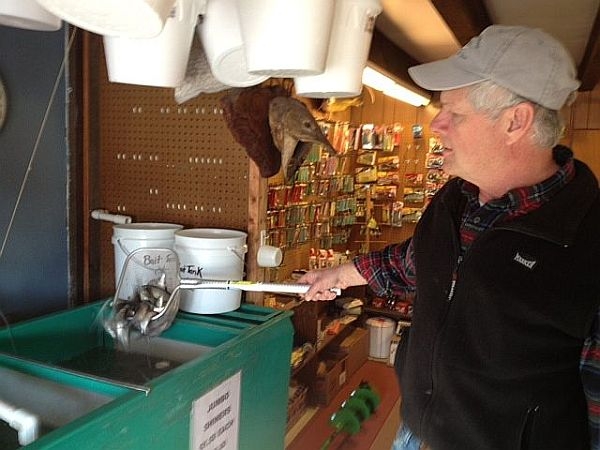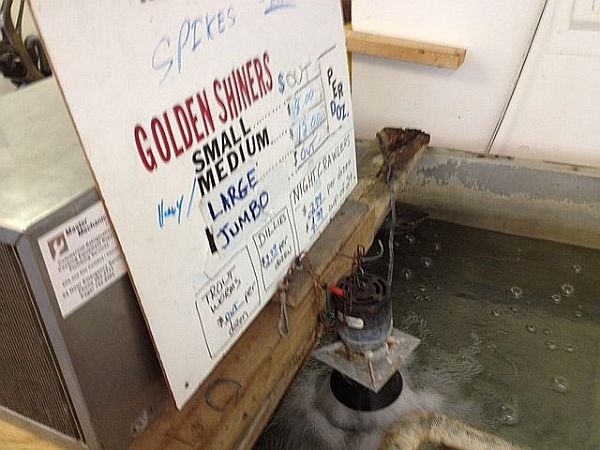
It’s prime season for ice fishing on Vermont’s waterways. And fisherman who use live bait are following new rules regulating their shiners and fatheads.
The change is an update to rules put in place five years ago to stop the spread of a deadly fish disease.
The bubblers are humming in the tanks that hold the bait fish at Dockside Outdoor Supply in Colchester. Ben Sullivan shows off the store’s Arkansas shiners, fat head and rosy reds, which he says are the bait everyone’s dragging around the ice these days.
Sullivan says the new baitfish rules are less restrictive and that’s made some fisherman happy:
"The biggest change for us is that you’re allowed to take bait home and you don’t have to discard after you’re done using them, which is nice for anglers because if they’re not biting that day they don’t have to throw out what they’ve bought," he said.
 When the rules were put into place in 2008, Vermont Fish And Wildlife officials were concerned about a fish disease that was spreading eastward from the Great Lakes. It’s called viral hemorrhagic septicemia and it killed thousands of fish. Suddenly, transporting bait fish between lakes was risky.
When the rules were put into place in 2008, Vermont Fish And Wildlife officials were concerned about a fish disease that was spreading eastward from the Great Lakes. It’s called viral hemorrhagic septicemia and it killed thousands of fish. Suddenly, transporting bait fish between lakes was risky.
Now fishermen also have to carry a receipt saying when they bought their bait and where they will be fishing.
And bait dealers had to make a choice: either sell certified bait fish, most of which is raised out of state, or continue to sell wild bait that can only be used in the waterbody where it was harvested.
Sullivan says his business decided to go for farmed bait that’s certified disease-free.
"It does hinder us a little bit from profit making because we have to purchase certified inspected bait that’s been inspected by Arkansas. So we can’t go out and catch the bait. We used to have a couple ponds fill them up with bait. Now we’re limited to one group of fisherman or limited to not growing bait," Sullivan explained.
Most bait shops have decided to sell only certified, commercially raised bait. The exceptions are bait shops in the Champlain Islands, like Holiday Harbor Lodge, where Joanne Batchelder show’s off the ice fishing shanties.
"We’ve got like seven of them. It’s nice and warm," she said.
Joanne and Bruce Batchelder own the North Hero fishing lodge in North Hero. Their out of state customers fish in the lodge’s shanties on Lake Champlain, and buy bait at the lodge’s front desk.
Bruce Batchelder says with Lake Champlain so close by, it’s not a problem to limit himself to one lake. But he says fisherman like being able to keep their bait longer.
 "Ability to fish it for four days is going to make it easier for fisherman to buy bait and use the bait up before dumping it out. The regulation, when it was first implemented was a wrinkle that people grumbled about then got used to it. People who want to fish with live bait will buy live bait," Batchelder said.
"Ability to fish it for four days is going to make it easier for fisherman to buy bait and use the bait up before dumping it out. The regulation, when it was first implemented was a wrinkle that people grumbled about then got used to it. People who want to fish with live bait will buy live bait," Batchelder said.
And most of his customers, like one group from Massachusetts buying shiners for a weekend of fishing don’t ask questions about the receipt.
"Basically I fill out the name of address our place, the body of water, date and time, the species purchased the person signs the slip I take one, they take one," Batchelder said.
Fish and Wildlife officials say while there have been some violations, most fisherman now understand the danger of transporting fish between waterways.
Many states now restrict the transportation of bait fish. And it’s working: the spread of viral hemorrhagic septicemia has slowed dramatically over the past few years. And while it came as close as New York, it has yet to be found in Vermont.